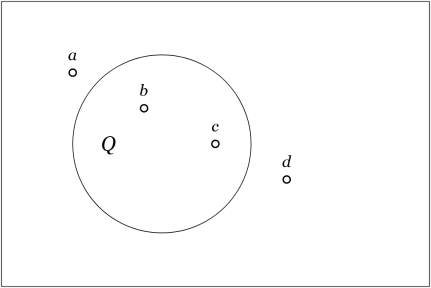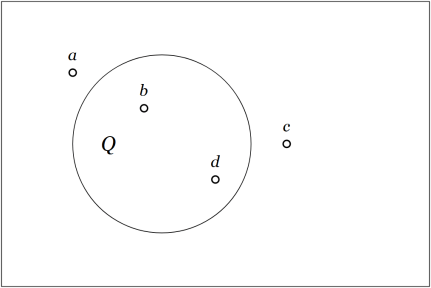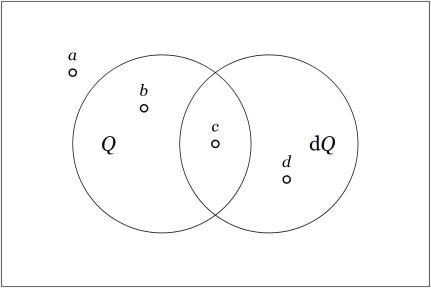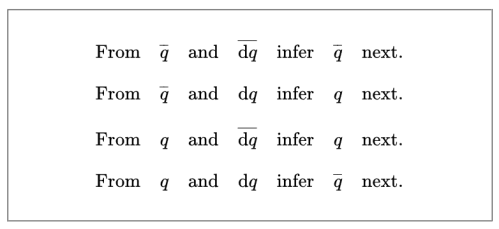A differential propositional calculus is a propositional calculus extended by a set of terms for describing aspects of change and difference, for example, processes taking place in a universe of discourse or transformations mapping a source universe to a target universe.
Casual Introduction
Consider the situation represented by the venn diagram in Figure 1.
The area of the rectangle represents a universe of discourse, The universe under discussion may be a population of individuals having various additional properties or it may be a collection of locations occupied by various individuals. The area of the “circle” represents the individuals having the property
or the locations in the corresponding region
Four individuals,
are singled out by name. It happens that
and
currently reside in region
while
and
do not.
Now consider the situation represented by the venn diagram in Figure 2.
Figure 2 differs from Figure 1 solely in the circumstance that the object is outside the region
while the object
is inside the region
So far, nothing says our encountering these Figures in this order is other than purely accidental but if we interpret this sequence of frames as a “moving picture” representation of their natural order in a temporal process then it would be natural to suppose
and
have remained as they were with regard to the quality
while
and
have changed their standings in that respect. In particular,
has moved from the region where
is true to the region where
is false while
has moved from the region where
is false to the region where
is true.
Figure 3 returns to the situation in Figure 1, but this time interpolates a new quality specifically tailored to account for the relation between Figure 1 and Figure 2.
This new quality, is an example of a differential quality, since its absence or presence qualifies the absence or presence of change occurring in another quality. As with any other quality, it is represented in the venn diagram by means of a “circle” distinguishing two halves of the universe of discourse, in this case, the portions of
outside and inside the region
Figure 1 represents a universe of discourse, together with a basis of discussion,
for expressing propositions about the contents of that universe. Once the quality
is given a name, say, the symbol
we have the basis for a formal language specifically cut out for discussing
in terms of
This language is more formally known as the propositional calculus with alphabet
In the context marked by and
there are just four distinct pieces of information which can be expressed in the corresponding propositional calculus, namely, the constant proposition
the negative proposition
the positive proposition
and the constant proposition
For example, referring to the points in Figure 1, the constant proposition holds of no points, the negative proposition
holds of
and
the positive proposition
holds of
and
and the constant proposition
holds of all points in the sample.
Figure 3 extends the basis of description for the space to a set of two qualities
and the corresponding terms of description to an alphabet of two symbols
Any propositional calculus over two basic propositions allows for the expression of sixteen propositions all together. Salient among those propositions in the present setting are the four which single out the individual sample points at the initial moment of observation. Table 4 lists the initial state descriptions, using overlines to express logical negations.
Table 5 shows the rules of inference responsible for giving the differential quality its meaning in practice.
Resources
cc: Cybernetics • Ontolog Forum • Peirce List • Structural Modeling • Systems Science






Pingback: Survey of Differential Logic • 3 | Inquiry Into Inquiry
Pingback: Survey of Differential Logic • 4 | Inquiry Into Inquiry
Pingback: Survey of Differential Logic • 5 | Inquiry Into Inquiry
Pingback: Survey of Differential Logic • 6 | Inquiry Into Inquiry